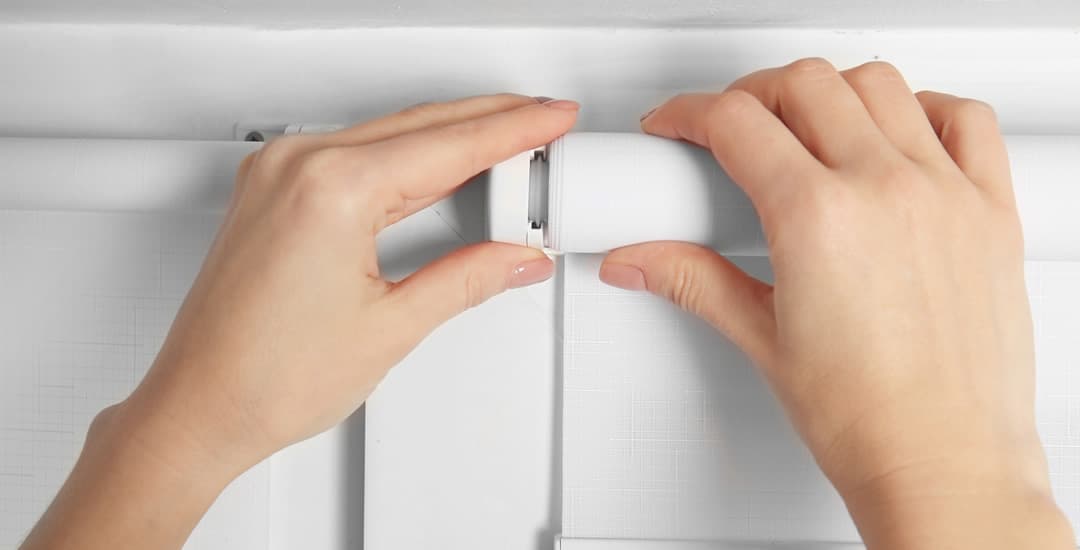
Can you install blinds yourself? Yes, and you don’t need a diploma in DIY to do so, nor any specialist tools. Many people get a bit daunted by the idea of installing their own blinds, but it’s no more complex that hanging a picture or drilling a couple of holes into a wall to fit a shelf; putting together something from Ikea is far more taxing and sweary, trust me.
Is it easy to install blinds yourself?
Yes, it really is. British window blind manufacturers like us put a lot of effort into ensuring that our blinds are user-friendly and easy to put up, and the instructions that come with them are succinct and easy-to-follow and written in plain (and native) English.
It’s also more convenient to install your own blinds than hiring someone else to do it, because you just do it when you can; you install blinds yourself, you get to pick when you get going, which means your blinds could arrive and be hanging on the wall the very same day.
You don’t need to wait to get an appointment with someone and then hope that they turn up for it!
Is it cheaper to install your own blinds?
Yes, definitely; or more to the point, installing your own blinds means that the price of the blind is your only expense.
Hiring and paying someone else to install blinds for you can actually be quite costly; perversely, precisely because it’s such a short, simple job (even if you’re talking about hanging several blinds) and honestly, not worth the while of most handypersons and odd-job services.
While professional window blind fitters do sort-of exist, they’re a dying breed, because there’s virtually no call for blinds fitting as a specialist service these days, and even large numbers of blinds fitted in commercial premises are often taken care of by general workers rather than dedicated blinds fitters.
Can you install blinds yourself without any special tools?
My idea of a comprehensive toolkit is duct tape, WD40, an adjustable wrench that won’t grip, plus two screwdrivers (one of the flat kind and the other of the hot cross bun-ended kind) respectively, all of which I bought in Poundland.
And yet you don’t see my neighbours calling the police every night when I get changed with the lights on, no sir, because I did indeed install my own blinds myself.
What do you need to install your own blinds, then?
The things you’ll definitely need are a pencil, a tape measure, a screwdriver, a power drill or power screwdriver (depending on how meatheaded your wall is), and a spirit level.
The spirit level can actually be downloaded as a phone app, seriously; and believe me, until you get one you will have literally NO idea how many things you can apparently benefit from taking a spirit level to. A bit like how none of us would be able to function these days without our phone torches either.
Also, depending on how high up you need to hang the blind, you might need a step ladder as well.
That’s literally it.
Can you replace your own blinds?
Yes, if you already have a set of blinds up then you need to remove them first and potentially, fill any drill holes in the wall that won’t match up with the fittings of the new set, and possibly repaint or make the wall good again if there are marks where the old blind’s fittings were.
Though, if the headrail of your new blind will cover any uglies left by the removal of the old one, the need for most of this might be moot anyway.
From there, you’re at the same start point as the whole “can you install blinds yourself from scratch” crowd.
What blinds are easiest to install?

There are no blinds that are “hard” to install per se, although you also need to factor in any challenges relating to your specific windows; like if they’re very high and hard to reach, or overall large, this latter meaning that the blind itself may be somewhat heavy and unwieldy without an assistant.
With that covered, some blinds are “easier” in that they have less steps or things to do when it comes to fitting them, and using this benchmark, the easiest blinds to install, in order, are:
Roller blinds
Roller blinds are the easiest of all blinds to install, as they only ever have two brackets. When the brackets are up, you just push the pin end of the blind into its bracket, locate the control end on the other bracket, and start, err, rolling.
See full instructions on how to install roller blinds.
Roman blinds
Wider Roman blinds might (but might not) have more than two brackets to put up; three, four, or even five for a biggun.’ However, fitting each bracket is no more hassle than fitting roller blind brackets, and usually just involves two screws.
When the brackets are up, just lift the blind into them and push it backwards until it clips into place.
See full instructions on how to install Roman blinds.
Aluminium Venetian blinds
Aluminium Venetian blinds more or less tie with Roman blinds, as they too may need more than two brackets to hold them, depending on the size of the blind. The brackets themselves are similar to Roman blind brackets in terms of how the blind slots into place within them.
See full instructions on how to install aluminium Venetian blinds.
Wooden blinds and faux-wood blinds
Wood and faux-wood blinds have two box brackets, one for each end of the blind, and each requiring two screws.
For wider wooden and faux-wood blinds, there may be another one or two support brackets needed along the length of the blind too.
The reason for wood and faux-wood blinds falling a bit further down the easy list is because you also need to fit the wood or faux-wood pelmet over the top of the blind’s headrail when you’re done, which is one more thing to do; but it’s not a brain-taxer.
You just need to fix the small brackets onto the back of the pelmet with the provided screw, then hang it on the headrail, and you’re good to go.
See full instructions on how to install wooden blinds and how to install faux-wood blinds.
Vertical blinds
Is it hard to install vertical blinds? No, even though they’re in last place; the gap between rollers and verticals is pretty much like the difficulty gap between like, beginner level 1 and beginner level 2 in a video game.
Why are verticals last then? Just because they’ve got more steps involved in hanging them than their horizontally-oriented pals.
First of all you need to fix their brackets to the wall or lintel, and there may be anything up to five of these to do, depending on the width of the blind.
You then position the headrail in the brackets and clip them into place for “head fix” brackets, or secure them with the provided screw for “face fix” or “frame fix” brackets.
Then, the most time-consuming but least-difficult part of all, you just hang each louvre onto the hooks on the headrail and push the weights into the bottom pocket of each louvre, before finally attaching the chain along the bottom of the row of weighted louvres.
See full instructions on how to install vertical blinds.
Come on, haven’t you done it yet?
I get lots and lots of enquiries from people who need a bit of reassurance to convince them that they’ll be able to fit their own blinds, plus a reasonable number of emails from others wanting a look at the actual real-life instructions they’re going to be getting before they buy; presumably having been catfished by “easy to follow instructions” in another context before.
What I have never received (to date) though is an email from someone who has tried to install their own blinds and then failed; but if you want to be the first and/or need a bit of reassurance or an early screening of the instructions you’ll get if you order from us, drop me an email (with a link to the blind you have your eye on, if relevant) and I will sort you out.




